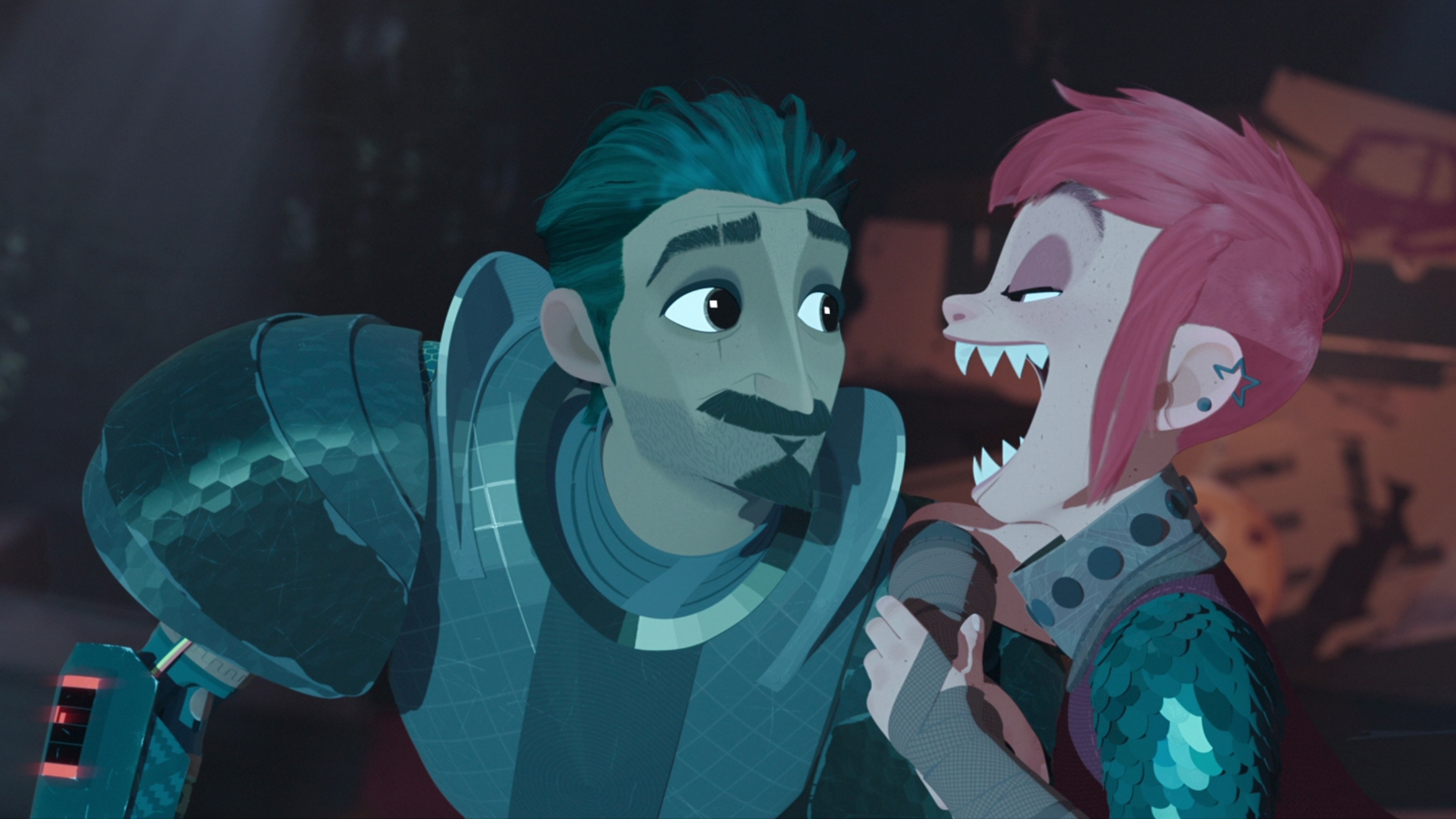Netflix’s ‘Nimona’ Is a Powerful, Joyful LGBTQIA+ Fantasy Romp

From the moment Nimona‘s titular anti-hero (Chloë Grace Moretz) enters the hideout of the shunned Sir Ballister Boldheart (Riz Ahmed), she models the kind of rebellion many “outsider” narratives only dream of embodying. Adapted from ND Stevenson’s Eisner Award-winning webcomic-turned-graphic novel of the same name, Netflix’s new animated film, Nimona, is a loving ode to its source material and a breathtaking sci-fi/fantasy story spotlighting the fluidity of identity, the danger of conservatism, and the importance of found family.
Nimona is far from a fairytale. The story follows an anarchist shapeshifter hellbent on destruction, who believes she’s found a kindred spirit in Ballister, who accidentally killed the queen during his knighting ceremony. She’s disappointed to learn that what she thinks is a “murder wall” in his lair is actually an “innocence wall,” because Ballister is desperate to figure out who framed him and why. He’s not evil, no matter what the conservative Institute that trained him claims, and all he wants is to clear his name. Nimona’s arrival throws him off for a number of reasons, not least of which is that she’s the kind of monster he’s been raised to hate—but she doesn’t like to be called a monster, for good reason.
They also make a very unlikely team. Ballister is the first child without noble blood to be inducted into the Institution. A queer kid of color from a lower caste than his peers, he spends every second of his life trying to prove himself. When he’s framed for the queen’s murder, it undoes everything he’s accomplished in mere seconds and destroys his closest relationship, a romance with fellow knight Sir Ambrosius Goldenloin (Eugene Lee Yang).
Ballister is quiet and determined, and believes he’s just fine on his own. Nimona is boisterous, eager, and happy to take risks, switching between forms so fast that it takes a few viewings of the movie to even catch all the creatures she becomes. Together, Ballister and Nimona challenge each other to be honest with who they are and what they want, while also attempting to accomplish a mutual goal through wildly opposing means.

Following in the footsteps of series and movies like Arcane and even Shrek, Nimona subverts the “happily ever after” trope and once again highlights why an “us vs. them” mentality is often necessary for people of marginalized identities. Nimona can’t maintain her humanoid form for long without feeling trapped in her skin, but shapeshifting makes her seem dangerous to everyone who encounters her. Her identity is fluid, as demonstrated through several conversations about who/what she is, and she makes no apologies or excuses for that.
Meanwhile, Ballister wants desperately to belong in the society that once claimed him—until he discovers how quickly they turn him out for something that isn’t remotely his fault. Together, Nimona and Ballister find a sense of peace, but that trust is hard-won on both sides of the relationship. Ambrosius complicates things in an interesting (if predictable) way and the secondary characters provide high-stakes pressure throughout.
Make no mistake: Nimona is an adventurous ride from the moment she enters the scene. The plot is somewhat predictable (even where it diverts from Stevenson’s graphic novel), but the movie is ultimately so much fun that it doesn’t actually matter. More importantly, Nimona is a major accomplishment for family-oriented animated media. Debuting on the final day of Pride Month in a year when U.S.-based LGBTQIA+ people are seeing lawmakers work harder and harder to take their rights away (but not without a fight), Nimona provides an hour and 42 minutes of queer power and joy in the face of extreme adversity. It’s escapist in the best way, and its dynamic animation style and energetic soundtrack—including an original score by Christophe Beck—make it stand out aesthetically, as well.
Truly the only noticeable flaw in Nimona is that the ending comes too soon. The story is well-paced up until the last 10 minutes, when everything wraps up very abruptly. There’s little room for interpretation, which in this case is a good thing, but I wanted more in those final moments after spending nearly two hours with the characters and falling so in love with them onscreen. That said, I think there’s potential for a sequel or a spinoff limited series, similar to how Tangled launched Rapunzel’s Tangled Adventure, which would be delightful.

A film adaptation of Nimona has been a long time coming. Following the New York Times bestselling graphic novel release by HarperCollins in 2015, an animated film was announced that same year by 20th Century Animation. The movie was scrapped when the Walt Disney Company acquired Fox in 2019, but it was revived by Netflix, Annapurna Pictures, and DNEG Animation in 2021.
Stevenson created the character while at the Maryland Institute College of Art, then published Nimona as a webcomic between 2012 and 2014 on Tumblr. In 2012, Nimona won a Cartoonist Studio Prize for best webcomic. In 2015, Stevenson became the youngest National Book Award nominee for the graphic novel reprint and took home an Eisner and a Cybils Award. A year later, Nimona was released as a fully-cast audiobook.
Nimona deserves every one of those accolades. The comic has been beloved for over a decade, and seeing it finally adapted for the screen is a dream come true for so many fans. Knowing the movie is written, directed, and produced with kids and families in mind, it’s a thrill to know that new generations will get to discover the characters and their journey, then fall in love the same way so many of Stevenson’s fans already have. This punchy, powerful, playful romp is worthy of multiple viewings, and each watch engenders the same warmth as the first.
Nimona premieres on Netflix on Friday, June 30.
(featured image: Netflix)
Have a tip we should know? [email protected]